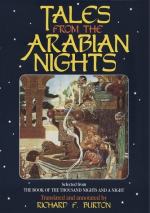[FN#41] This is the “insane herb.” Davis, who visited Sumatra in 1599 (Purchas i. 120) speaks “of a kind of seed, whereof a little being eaten, maketh a man to turn foole, all things seeming to him to be metamorphosed.” Linschoten’s “Dutroa” was a poppy-like bud containing small kernels like melons which stamped and administered as a drink make a man “as if he were foolish, or out of his wits.” This is Father Lobo’s “Vanguini” of the Cafres, called by the Portuguese dutro (Datura Stramonium) still used by dishonest confectioners. It may be Dampier’s Ganga (Ganjah) or Bang (Bhang) which he justly describes as acting differently “according to different constitutions; for some it stupefies, others it makes sleepy, others merry and some quite mad.” (Harris, Collect. ii. 900.) Dr. Fryer also mentions Duty, Bung and Post, the Poust of Bernier, an infusion of poppy-seed.
[FN#42] Arab. “Ghul,” here an ogre, a cannibal. I cannot but regard the “Ghul of the waste” as an embodiment of the natural fear and horror which a man feels when he faces a really dangerous desert. As regards cannibalism, Al-Islam’s religion of common sense freely allows it when necessary to save life, and unlike our mawkish modern sensibility, never blames those who
Alimentis talibus usi
Produxere animos.
[FN#43] For Cannibals, see the Massagetae of Herod (i.), the Padaei of India (iii.), and the Essedones near Maeotis (iv.); Strabo (lib. iv.) of the Luci; Pomponious Mela (iii. 7) and St. Jerome (ad Jovinum) of Scoti. M. Polo locates them in Dragvia, a kingdom of Sumatra (iii. 17), and in Angaman (the Andamanian Isles?), possibly the ten Maniolai which Ptolemy (vii.), confusing with the Nicobars, places on the Eastern side of the Bay of Bengal; and thence derives the Heraklian stone (magnet) which attracts the iron of ships (See Serapion, De Magnete, fol. 6, Edit. of 1479, and Brown’s Vulgar Errors, p. 74, 6th Edit.). Mandeville finds his cannibals in Lamaray (Sumatra) and Barthema in the “Isle of Gyava” (Java). Ibn Al-Wardi and Al-Kazwini notice them in the Isle Saksar, in the Sea of the Zanj (Zanzibar): the name is corrupted Persian “Sag-Sar” (Dogs’-heads) hence the dog-descended race of Camoens in Pegu (The Lus. x. 122). The Bresl. Edit. (iv. 52) calls them “Khawarij"=certain sectarians in Eastern Arabia. Needless to say that cocoa-nut oil would have no stupefying effect unless mixed with opium or datura, hemp or henbane.
[FN#44] Black pepper is produced in the Goanese but we must go south to find the “Bilad al-Filfil” (home of pepper) i.e. Malabar. The exorbitant prices demanded by Venice for this spice led directly to the discovery of The Cape route by the Portuguese; as the “Grains of Paradise” (Amomum Granum Paradisi) induced the English to explore the West African Coast.
[FN#45] Arab. “Kazdir.” Sansk. “Kastir.” Gr. “Kassiteron.” Lat. “Cassiteros,” evidently derived from one root. The Heb. is “Badih,” a substitute, an alloy. “Tanakah” is the vulg. Arab. word, a congener of the Assyrian “Anaku,” and “Kala-i” is the corrupt Arab. term used in India.




